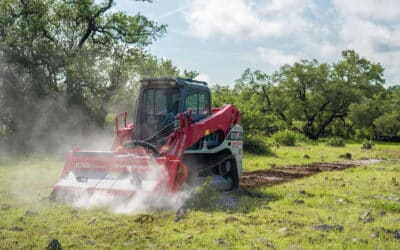Invasive species aren’t only a matter of aesthetics; they also threaten the health of local ecosystems. This non-native living organism—whether a plant or animal—can outcompete those inherent to an environment, disrupt their habitats, and cause irreparable damage. In this blog, we’ll explore actionable strategies to help you identify and remove invasive species while highlighting how Fecon’s equipment is essential for this process.
Understanding Invasive Species
Before diving into the best ways to remove invasive species, let’s cover what they are and how to spot them on your property. Invasive species are non-native organisms that, when introduced to new environments, thrive due to the absence of natural predators. They can severely impact local ecosystems, reducing biodiversity, altering soil chemistry, and disrupting food chains. Here are a few of the most common types:
- Kudzu (Southeastern U.S.): This fast-growing vine can overtake entire areas, smothering native plants.
- Purple Loosestrife (Northern U.S.): Known for its vibrant flowers, it invades wetlands and outcompetes native flora.
- Japanese Knotweed (East Coast): This perennial plant can damage structures and flood defenses, making it a nuisance for property owners.
- Honey Suckle (Midwest): Non-native shrubs introduced in the United States for landscaping and erosion control, Honey Suckle spread rapidly, outcompeting native plants for resources and disrupting local ecosystems.
Identifying Invasive Species on Your Property
So, what exactly should you look for when identifying invasive species?
- Rapid Growth: Many invasive species grow more quickly than natives, forming dense thickets or mats.
- Distinctive Features: You can often identify invasive species by their leaves, flowers, and growth habits.
- Ecosystem Changes: Notice if some regions of your property are becoming less biodiverse or if native plants struggle to thrive.
A thorough inventory of your landscape can help pinpoint invasive species early, preventing larger infestations.
Effective Invasive Species Removal Strategies
Once you’ve identified invasive species on your property, it’s time to act. Let’s focus on some of the best removal methods, which will depend on the size of your property and the amount of disposal needed:
Manual Removal
Manual removal can be effective for more minor infestations. Simple hand tools can do a great deal of good to pull out plants. Just make sure you remove the entire root system to prevent regrowth.
Chemical Treatments
Herbicides can be effective for larger infestations but use with caution. Always follow local regulations and guidelines, and consider the potential impact on surrounding wildlife and native plants.
Biological Control
This method involves using natural predators or pathogens to manage invasive species. While it can be effective, it requires careful consideration to avoid unintended consequences on the ecosystem.
Mechanical Removal with Fecon Mulchers
Mechanical removal may be necessary for extensive or challenging infestations. Fecon mulchers provide an efficient solution for clearing invasive species quickly and effectively. Our robust machines can grind down invasive plants, turning them into mulch that can help nourish the soil, thereby preventing regrowth.
Using Fecon Mulchers for Invasive Species Control
We specifically designed Fecon mulchers for challenging terrain and heavy-duty applications. Their benefits include:
- Efficiency: Mulchers can clear large areas in a fraction of the time it would take using manual methods.
- Soil Health: The mulch created by invasive species can enhance soil quality, improving conditions for native plants.
- Reduced Regrowth: By grinding down the plants and roots, Fecon mulchers help minimize the chance of regrowth, allowing for more effective long-term management.
Preventing Future Invasions
Once you’ve managed existing invasive species, the goal is to ensure they don’t return. Here’s how:
- Regular Monitoring: Schedule regular property inspections to catch new invasions early.
- Native Plant Restoration: Consider replanting native species to outcompete potential invasive ones.
- Educate Yourself and Neighbors: Share knowledge about invasive species and their impacts. Community awareness can lead to collective action and more effective management.
By implementing these practices, you’ll create a healthier ecosystem that supports local biodiversity and enhances the value of your property.
Remove Invasive Species With Help From Fecon
By understanding invasive species’ threats, identifying their presence, and employing effective removal strategies—especially with tools like Fecon mulchers—you can protect your land and promote a thriving ecosystem. Have more questions about invasive species? Contact us anytime. We’re always here to help.


